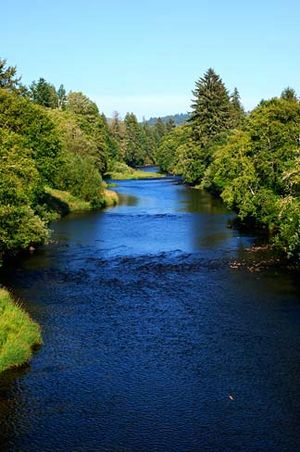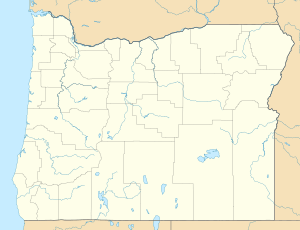Siletz River facts for kids
Quick facts for kids Siletz River |
|
|---|---|

Siletz River
|
|
|
Location of the mouth of the Siletz River in Oregon
|
|
| Country | United States |
| State | Oregon |
| County | Polk and Lincoln |
| Physical characteristics | |
| Main source | Confluence of north and south forks near Valsetz, Polk County 708 ft (216 m) 44°52′48″N 123°42′40″W / 44.88000°N 123.71111°W |
| River mouth | Siletz Bay near Lincoln City, Lincoln County 0 ft (0 m) 44°54′12″N 124°00′41″W / 44.90333°N 124.01139°W |
| Length | 67.5 mi (108.6 km) |
| Basin features | |
| Basin size | 373 sq mi (970 km2) |
The Siletz River is a beautiful river in Oregon, USA. It flows for about 67 miles (108 km) through coastal mountains. The river starts where its north and south forks meet near Valsetz in Polk County. It then winds its way through the Central Oregon Coast Range.
The Siletz River drains a large area of about 373 square miles (966 km²). It eventually empties into Siletz Bay. This bay is located south of Lincoln City in Lincoln County. Even though the river is 67 miles long, its starting point is only about 20 miles (32 km) east of the ocean. This shows how much it twists and turns!
Contents
Journey of the Siletz River
The Siletz River begins just east of the border between Polk and Lincoln counties. This area is part of the Siuslaw National Forest in the Central Oregon Coast Range.
Flowing Through Counties
The river first flows west and enters Lincoln County. Then it goes back into Polk County for a short bit. Finally, it re-enters Lincoln County for the last time, about 66 miles (106 km) from where it meets the ocean.
As the river moves, many smaller streams, called creeks, join it. For example, Blind Creek joins from the left side. Further on, Elk and Holman creeks join from the right. Sunshine Creek comes in from the left, and Buck Creek from the right. Wolfer Creek also adds its water from the left side.
Twists and Turns
About 57 miles (92 km) from its mouth, the river turns west. Soon after, Wildcat Creek joins from the right. In some parts of its upper journey, the Siletz River flows near lands that belong to the Siletz Reservation.
The river then turns southwest and south. Palmer Creek joins from the right. The river flows past Moonshine County Park. Then, Baker Creek and Mill Creek join from the left. The river reaches Logsden, which is about 47 miles (76 km) from the ocean.
After passing under Rock Creek Road, the river gets more water from Rock Creek on the left. It turns west again. Scott Creek joins from the right, and Sam Creek from the left. Bentilla and Baker creeks also join, both from the right.
Reaching Siletz City
The Siletz River continues south and then west, running alongside Upper Siletz Road. It passes a special measuring station run by the United States Geological Survey (USGS). The river then reaches the city of Siletz, about 41 miles (66 km) from its mouth. In Siletz, Mill and Dewey creeks join from the left.
The river makes many loops and turns around the city of Siletz. It even goes under Oregon Route 229 twice! After these turns, the river heads north, staying close to Route 229 all the way to Siletz Bay. In this part, Tangerman, Spencer, and Thompson creeks all join from the right.
Journey to the Bay
About 35 miles (56 km) from the mouth, the river turns west. It flows under Route 229 at Ojalla Bridge. Then, Ojalla Creek joins from the left. The river continues to twist and turn, flowing north, then east, then north again. Euchre Creek and Reed creeks join from the right.
About 25 miles (40 km) from the mouth, the river makes another sharp turn to the west. It flows past Jack Morgan County Park. Chitwood, Hough, and Wade creeks all join from the right. Cedar and Misac creeks also enter from the right. Jaybird Creek joins from the left. About 20 miles (32 km) from the mouth, Roy Creek joins from the left.
Over the next 3 miles (5 km), the river loops back on itself. It flows west, then north, then east, almost returning to Roy Creek. Then it turns north. Roots, Skalada, Townsend, and Stemple creeks all join quickly from the right. Shortly after, Scare Creek enters from the left.
Butterfield Creek joins from the left. The river then makes another sharp turn to the east. Foster Creek joins from the left, and Reed Creek from the right, about 10 miles (16 km) from the mouth.
Turning north and then west again, the river receives Bear, Skunk, Barhaven, and Anderson creeks over the next 5 miles (8 km), all from the right. A smaller branch of the river, called Millport Slough, splits off to the left as the river gets closer to Siletz Bay and the Siletz Bay National Wildlife Refuge. The river finally reaches Kernville, flows under U.S. Route 101, and enters the bay.
River Flow and Measurement
The USGS measures how much water flows in the Siletz River. There is a station east of Siletz, about 42.6 miles (68.6 km) from the river's mouth.
- The average amount of water flowing at this station is about 1,500 cubic feet per second (42 m³/s).
- This measurement comes from about 54 percent of the total Siletz River area.
- The most water ever recorded there was 53,800 cubic feet per second (1,523 m³/s) on November 28, 1999.
- The least water recorded was 42 cubic feet per second (1.2 m³/s) on September 5–6, 2003.
- Ocean tides affect the river's flow for the last 22.5 miles (36.2 km) of its journey.
Fishing Fun
The Siletz River is known as a great place for fishing. It's easy to get to, which makes it popular.
What Fish Can You Catch?
You can catch several types of sport fish here:
- Fall chinook salmon
- Summer and winter steelhead (which are a type of rainbow trout)
- coastal cutthroat trout
Best Fishing Spots
Fishing from a boat is most common between Moonshine Park and Jack Morgan Park. The city of Siletz has a boat ramp, parking, and a picnic area right by the river. The lower part of the river and the bay also have many places where you can rent boats and fishing gear.


